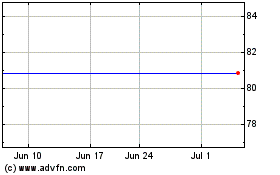FAME Trial Two-Year Follow-Up Results Demonstrate Continued Reduction in Risk of Death or Heart Attack When Physicians Use St...
September 23 2009 - 3:51PM
Business Wire
St. Jude Medical, Inc. (NYSE:STJ) today announced that the
two-year results from the landmark FAME (Fractional Flow Reserve (FFR) vs.
Angiography in Multivessel Evaluation) trial demonstrated the
durability of the improved outcomes noted at one-year for patients
with multivessel coronary artery disease whose treatment was guided
by FFR rather than by standard angiography alone. Two-year results
demonstrated that the risk of death or myocardial infarction (heart
attack) was 34% lower for patients whose treatment was guided by
St. Jude Medical’s PressureWire technology prior to coronary
stenting.
The two-year results demonstrated that patients who received
FFR-guided treatment had increasingly superior outcomes over time;
the two patient groups had a difference in patient death and
myocardial infarction of 3.8% after 12 months and 4.3% after two
years.
Study results also showed that at two years:
- The risk of a patient dying or
having a heart attack was reduced by approximately 34% when FFR
measurement was performed prior to stenting. (12.7% for the
angiography-guided group compared to 8.4% for the FFR-guided
group.)
- The risk of a patient having a
heart attack was 6.1% for the FFR-guided group, compared to 9.7% in
the control group, a reduction of 37%
- Only one out of 513, or 0.2%, of
deferred lesions resulted in a late myocardial infarction
- Use of FFR technology did not
increase average procedural times
After one year, FFR-guided treatment was also demonstrated to be
cost-saving, with a difference of about $2,000, or 14%, between
total healthcare costs for the FFR-guided cohort and the group
treated by angiography alone. These lower healthcare costs were a
result of reduced procedural costs, reduced follow-up costs for
major adverse cardiac events and shorter hospital stays.
“The two-year data from the FAME study continue to show improved
outcomes when multivessel coronary stenting is guided by
measurement of FFR,” said co-principal investigator of the FAME
study William F. Fearon, M.D., associate director of interventional
cardiology at Stanford University Medical Center, Palo Alto, Calif.
“Use of FFR technology represents a rare opportunity in medicine in
which an innovative product not only improves clinical outcomes but
also saves money.”
The FAME study was a randomized, prospective, multi-center trial
which enrolled 1,005 patients with multivessel coronary artery
disease. It compared outcomes for patients whose treatment was
guided by FFR to those whose treatment was guided only by
angiography 12 months after receiving a stent. The two-year results
from the study, which exclusively used St. Jude Medical’s
PressureWire™ Certus technology to measure FFR, were presented
today at a late-breaking clinical trial at TCT 2009, the annual
scientific symposium of the Cardiovascular Research Foundation. The
12-month results from the FAME study were published in the January
15, 2009 issue of the New England Journal of Medicine.
St. Jude Medical’s FFR technology, which includes both the
PressureWire Certus and the PressureWire™ Aeris, is one example of
the company’s focus on developing products which aid physicians in
practicing medicine more proactively. The PressureWire technology
enables physicians to pinpoint which specific lesion or lesions are
responsible for a patient’s ischemia, giving them the information
upon which they can determine the best treatment option for each
patient. The PressureWire Aeris, which was recently launched in the
U.S., uses wireless technology, removing the need for cables to
cross the sterile field, introducing fewer variables and making the
entire procedure faster and easier.
Transcatheter Cardiovascular Therapeutics (TCT) is the annual
scientific symposium of the Cardiovascular Research Foundation.
Attended by over 10,000 participants each year, TCT gathers leading
medical researchers and clinicians from around the world to present
and discuss the latest developments in the field of interventional
cardiovascular medicine.
About Fractional Flow Reserve (FFR)
Fractional Flow Reserve (FFR) is an index determining the
functional severity of narrowings in the coronary arteries as
measured by PressureWire Certus and PressureWire Aeris. FFR
specifically identifies which coronary narrowings are responsible
for significantly obstructing the flow of blood to a patients’
heart muscle (called ischemia), and it is used by the
interventional cardiologist to direct coronary interventions and
assess results for improved treatment outcomes.
About St. Jude Medical
St. Jude Medical develops medical technology and services that
focus on putting more control into the hands of those who treat
cardiac, neurological and chronic pain patients worldwide. The
company is dedicated to advancing the practice of medicine by
reducing risk wherever possible and contributing to successful
outcomes for every patient. Headquartered in St. Paul, Minn., St.
Jude Medical employs approximately 15,000 people worldwide and has
four major focus areas that include: cardiac rhythm management,
atrial fibrillation, cardiovascular and neuromodulation. For more
information, please visit sjm.com.
Forward-Looking Statements
This news release contains forward-looking statements within the
meaning of the Private Securities Litigation Reform Act of 1995
that involve risks and uncertainties. Such forward-looking
statements include the expectations, plans and prospects for the
Company, including potential clinical successes, anticipated
regulatory approvals and future product launches, and projected
revenues, margins, earnings and market shares. The statements made
by the Company are based upon management’s current expectations and
are subject to certain risks and uncertainties that could cause
actual results to differ materially from those described in the
forward-looking statements. These risks and uncertainties include
market conditions and other factors beyond the Company’s control
and the risk factors and other cautionary statements described in
the Company’s filings with the SEC, including those described in
the Risk Factors and Cautionary Statements sections of the
Company’s Quarterly Report on Form 10-Q for the fiscal quarter
ended April 4, 2009 and July 4, 2009. The Company does not intend
to update these statements and undertakes no duty to any person to
provide any such update under any circumstance.
SJM (NYSE:STJ)
Historical Stock Chart
From Jun 2024 to Jul 2024

SJM (NYSE:STJ)
Historical Stock Chart
From Jul 2023 to Jul 2024
